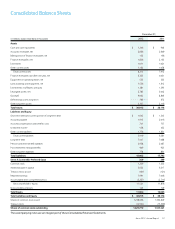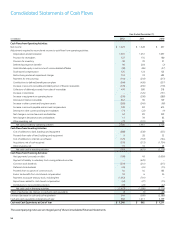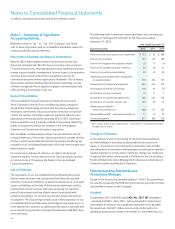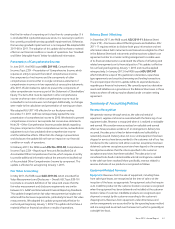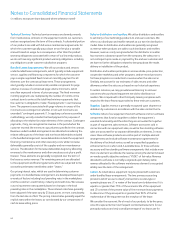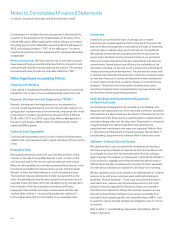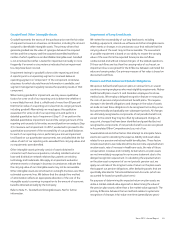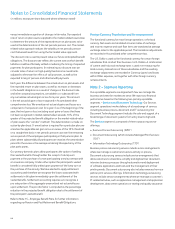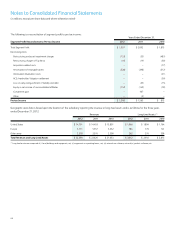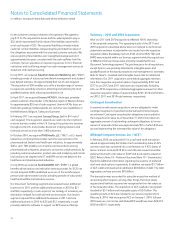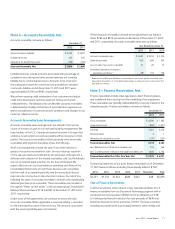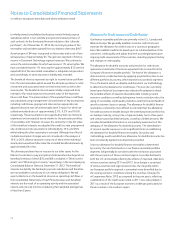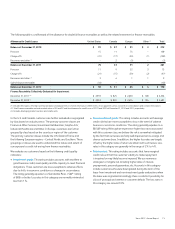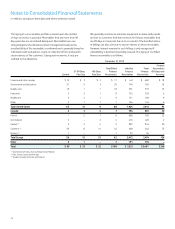Xerox 2012 Annual Report Download - page 68
Download and view the complete annual report
Please find page 68 of the 2012 Xerox annual report below. You can navigate through the pages in the report by either clicking on the pages listed below, or by using the keyword search tool below to find specific information within the annual report.Notes to Consolidated Financial Statements
(in millions, except per-share data and where otherwise noted)
66
versus immediate recognition of changes in fair value. Our expected
rate of return on plan assets is applied to the market-related asset value
to determine the amount of the expected return on plan assets to be
used in the determination of the net periodic pension cost. The market-
related value approach reduces the volatility in net periodic pension
cost that would result from using the fair market value approach.
The discount rate is used to present value our future anticipated benefit
obligations. The discount rate reflects the current rate at which benefit
liabilities could be effectively settled considering the timing of expected
payments for plan participants. In estimating our discount rate, we
consider rates of return on high-quality fixed-income investments
adjusted to eliminate the effects of call provisions, as well as the
expected timing of pension and other benefit payments.
Each year, the difference between the actual return on plan assets and
the expected return on plan assets, as well as increases or decreases
in the benefit obligation as a result of changes in the discount rate
and other actuarial assumptions, are added to or subtracted from
any cumulative actuarial gain or loss from prior years. This amount
is the net actuarial gain or loss recognized in Accumulated other
comprehensive loss. We amortize net actuarial gains and losses as a
component of net pension cost for a year if, as of the beginning of the
year, that net gain or loss (excluding asset gains or losses that have
not been recognized in market-related value) exceeds 10% of the
greater of the projected benefit obligation or the market-related value
of plan assets (the “corridor” method). This determination is made on
a plan-by-plan basis. If amortization is required for a particular plan, we
amortize the applicable net gain or loss in excess of the 10% threshold
on a straight-line basis in net periodic pension cost over the remaining
service period of the employees participating in that pension plan. In
plans where substantially all participants are inactive, the amortization
period for the excess is the average remaining life expectancy of the
plan participants.
Our primary domestic plans allow participants the option of settling
their vested benefits through either the receipt of a lump-sum
payment or the purchase of a non-participating annuity contract with
an insurance company. Under either option the participant’s vested
benefit is considered fully settled upon payment of the lump-sum or
the purchase of the annuity. We have elected to apply settlement
accounting and therefore we recognize the losses associated with
settlements in this plan immediately upon the settlement of the
vested benefits. Settlement accounting requires us to recognize a
pro rata portion of the aggregate unamortized net actuarial losses
upon settlement. The pro rata factor is computed as the percentage
reduction in the projected benefit obligation due to the settlement of
the participant’s vested benefit.
Refer to Note 15 – Employee Benefit Plans for further information
regarding our Pension and Post-Retirement Benefit Obligations.
Foreign Currency Translation and Re-measurement
The functional currency for most foreign operations is the local
currency. Net assets are translated at current rates of exchange
and income, expense and cash flow items are translated at average
exchange rates for the applicable period. The translation adjustments
are recorded in Accumulated other comprehensive loss.
The U.S. Dollar is used as the functional currency for certain foreign
subsidiaries that conduct their business in U.S. Dollars. A combination
of current and historical exchange rates is used in re-measuring the
local currency transactions of these subsidiaries and the resulting
exchange adjustments are recorded in Currency (gains) and losses
within Other expenses, net together with other foreign currency
remeasurments.
Note 2 – Segment Reporting
Our reportable segments are aligned with how we manage the
business and view the markets we serve. We report our financial
performance based on the following two primary reportable
segments – Services and Document Technology. Our Services
segment operations involve delivery of a broad range of services
including business process, document and IT outsourcing. Our
Document Technology segment includes the sale and support of a
broad range of document systems from entry level to high-end.
The Services segment is comprised of three outsourcing service
offerings:
• Business Process Outsourcing (“BPO”)
• Document Outsourcing (which includes Managed Print Services)
(“DO”)
• Information Technology Outsourcing (“ITO”)
Business process outsourcing services include service arrangements
where we manage a customer’s business activity or process.
Document outsourcing services include service arrangements that
allow customers to streamline, simplify and digitize their document-
intensive business processes through automation and deployment
of software applications and tools and the management of their
printing needs. Document outsourcing also includes revenues from our
partner print services offerings. Information technology outsourcing
services include service arrangements where we manage a customer’s
IT-related activities, such as application management and application
development, data center operations or testing and quality assurance.



